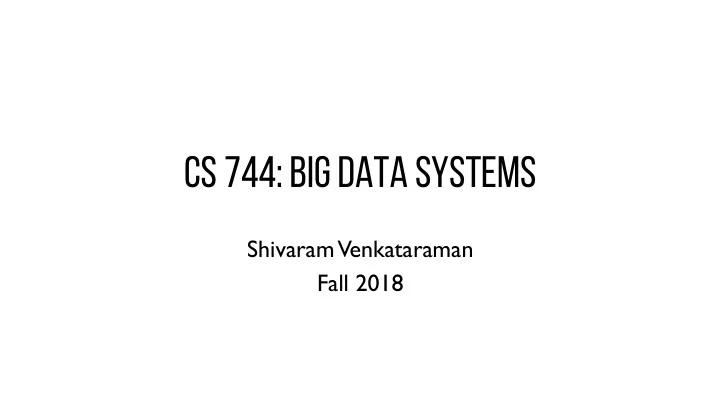

CS 744: Big Data Systems Shivaram Venkataraman Fall 2018
ADMINISTRIVIA - Assignment 2 grades: Tonight - Midterm review session on Nov 2 at 5pm at 1221 CS - Course Project Proposal feedback
EFFICIENT SQL ON MODERN HARDWARE
MOTIVATION Query Model - Need to handle diverse queries - Real-time streaming, temporal queries on logs, progressive queries etc. Language Integration - Support for High-level Language (HLL) - SQL Library Performance
approach 1. Temporal Logical Data Model 2. DAG of operators (Volcano, Spark, DryadLINQ etc.) 3. Performance i. Data batching ii. Columnar processing iii. Code Generation iv. Efficient Aggregation
ARCHITECHTURE
DATA MODEL, QUERY LINQ style queries Similar to SparkSQL, DryadLINQ Includes timestamp by default Support for windowing, aggregation var str = Network.ToStream(e => e.ClickTime, Latency(10secs)); var query = str.Where(e => e.UserId % 100 < 5) .Select(e => { e.AdId }) .GroupApply(e => e.AdId, s => s.Window(5min).Aggregate(w => w.Count()));
DATA BATCHING Why is batching important ? Vectorized operations, better throughput Implementing batching Group a set of events together, each having sync time Aadaptively choose batch size Insert punctuation to enforce batch gets flushed Example: Punctuation every 5min, batch contains 500 tuples Throughput is 1000 tuples/sec à 600 batches each punctuation
COLUMNAR PROCESSING: LAYOUT class DataBatch { - Separate into control, payload fields long[] SyncTime; long[] OtherTime; Bitvector BV; - BitVector to indicate absence } class UserData_Gen : DataBatch { - Each of these has columnar layout long[] col_ClickTime; long[] col_UserId; Payload generated from user struct long[] col_AdId; - }
COLUMNAR PROCESSING: OPERATORS Operators à nodes in query DAG void On(UserData_Gen batch) { Chain operators together with On() batch.BV.MakeWritable(); for (int i=0;i<batch.Count; i++) if ((batch.BV[i] == 0) && Tight-loop from code-gen !(batch.col_UserId[i] % 100<5)) batch.BitVector[i] = 1; Further optimizations: nextOperator.On(batch); Copy-on-write, } Zero-copy pointer-swing
COLUMNAR PROCESSING: OTHER Serialization - Store data in column batches - Code generation of serialization/deserialization String Handling - Bloated string representation in Java/C# - Encode multiple strings into MultiString - stringsplit, substring – operate directly on MultiString
GROUPED AGGREGATION Temporal Data Model - Each event belongs to a data window or interval - Aggregates can be stateless or stateful (more in next 3 lectures) other_time - When other_time > sync_time, represents interval - When other_time is infinity, start at sync_time - When other_time < sync_time, end at sync_time
GROUPED AGGREGATION API for user-defined aggregation functions Efficient implementation using three data structures Example for count: InitialState: () => 0L Accumulate: (oldCount, timestamp, input) => oldCount + 1 Deaccumulate: (oldCount, timestamp, input) => oldCount - 1 Difference: (leftCount, rightCount) => leftCount - rightCount ComputeResult: count => count
MAP-REDUCE on MULTI-CORE
SUMMARY Flexible SQL library to handle workload patterns Integration with high-level language Efficient execution through - Batching - Columnar processing - Code generation
Recommend
More recommend